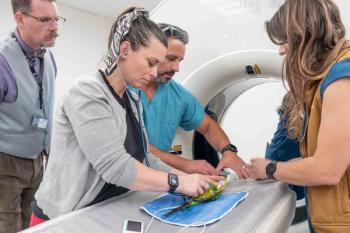
Thoracic radiography: Heart and pulmonary vasculature (Proceedings)
Radiographic assessment of the heart and pulmonary vessels is challenging regardless of the species. This is due to numerous factors including variation between species and breeds, exposure factors, effects of the cardiac and respiratory cycles, radiographic positioning and quality of x-ray equipment.
Radiographic assessment of the heart and pulmonary vessels is challenging regardless of the species. This is due to numerous factors including variation between species and breeds, exposure factors, effects of the cardiac and respiratory cycles, radiographic positioning and quality of x-ray equipment. The cardiac silhouette includes the not only the heart, but pericardial fluid, fat and the pericardial sac. Thus, an enlarged cardiac shadow can result from more than cardiomegaly.
Technical considerations
Three radiographic projections are recommended for evaluating the thorax: 1) either a ventrodorsal or dorsoventral projection and 2) left and 3) right lateral views. Both lateral views are needed because the dependent lung is compressed by overlying tissues reducing inflation and subject contrast. As a result, normal structures like vessels and bronchi will not be visualized. In addition, soft tissue changes such as alveolar opacities in the dependent lung will not be seen. The left lateral view is superior for assessing the cranial lobar pulmonary vessels and should always be made in evaluating dogs and cats with cardiopulmonary disease. Debate exists between cardiologists and radiologists regarding use of ventrodorsal versus dorsoventral radiographs. Either can be used to assess the heart and pulmonary vessels, however it should be kept in mind that the caudal lobar vessels are significantly magnified on the dorsoventral compared to the ventrodorsal view due to increased object to film distance. This may cause confusion when ventrodorsal and dorsoventral views are used interchangeably, especially on a follow up examination of the same patient.
Diagnostic quality thoracic radiographs are obtained by using short exposure times (1/60 second or less), making the exposure at peak inspiration and using strict positioning, especially on the ventrodorsal/dorsoventral projection. Motion artifact is present on projections made with exposures greater than 1/60 second and panting animals cannot be reliably imaged. Critical evaluation of the cardiac silhouette and vasculature is compromised on views that are made with oblique positioning. Radiographs made during expiration often give a false impression of cardiomegaly and increased opacity of the pulmonary parenchyma. A wide scale of subject contrast is preferred for thoracic radiographs in order to visualize the entire lung field. Because of the variation in thickness of the thorax and the different radiopacities (air, soft tissue/fluid and fat) a bright light source is necessary to visualize dark areas of conventional (analog) radiographs. However, digital radiographic systems provide a wider range of subject contrast improving visualization of the entire lung field and are generally superior for thoracic radiography.
Normal radiographic findings
The normal cardiac shadow is generally subjectively evaluated on the lateral radiograph, but objective methods are often used, especially to document changes in cardiac size relative to therapy. For most normal dogs, cardiac shadow occupies about 3 rib spaces on the lateral projection and 21/2 for cats. The vertebral heart scale method is also used estimation of cardiac size. The lengths in short and long axis of the heart are measured on the lateral view and summed. Normal for dogs ranges from 8.7 to 10.7 vertebral lengths (9.7+/- 0.5). In cats, the mean is 7.5 +/- 0.3. In dogs there is a wide range because of breed variation. These methods are should be used with caution because animals outside of the norm may not have cardiac disease and conversely, cardiac patients can have a normal VHS. It should also be mentioned that trained radiologists and other specialists have not found this method superior to subjective evaluation. Cardiac size is affected by systole and diastole, with the heart generally appearing larger in diastole due to chamber filling than in systole when contraction is occurring; this is more noticeable in dogs versus cats. Some dogs normally have larger hearts than expected, including athletes, such as the racing greyhound, chodrodystrophic and heavily muscled breeds. The heart may appear small in normal collie type breeds.
Cardiac shape varies with breed is affected by the position of the heart in the thorax. When the heart has a vertical position within the thorax (Doberman pinscher, Dachshund, Beagle, etc) the heart will has a reverse D shape on the ventrodorsal view, giving a false impression of right heart enlargement. With a less vertical and more horizontal position, as in retrievers and shepherds and in most cats, the heart will have a more elongated shape on the ventrodorsal view. It is important to carefully assess the heart's position when assessing the ventrodorsal radiograph. Abnormal cardiac shape is due to various changes in contour of the cardiac silhouette and is generally assessed on the ventrodorsal or dorsoventral view, using the lateral views for conformation.
Assessment of the pulmonary vasculature requires excellent quality radiographs accurate patient positioning and a working knowledge of normal vascular anatomy of the thorax. The great vessels including the aorta and vena cava are well seen on thoracic radiographs. The aortic arch and descending aorta are can be evaluated and can change with various disease processes. In the cat aging is associated with development of a prominent aortic bulge at the 1 o'clock position on the ventrodorsal view that is often confused with a mediastinal mass. Both the cranial and the caudal vena cava are seen on radiographs of normal animal. In particular the caudal vena cava can be assessed for changes in size due to congestion or hypovolemia. However the cava has thin walls and can be come oval shaped in cross section during peak inflation, causing it to be falsely narrowed on the lateral view or falsely widened on the ventrodorsal view. The main pulmonary artery segment is very short and occupies the 1:30 o'clock position on the ventrodorsal view, just lateral and distal to the aortic arch. It divides into left and right branches with the left branch passing ventral to the trachea and the right dorsal to the trachea. These vessels are not routinely seen in normalcy. The peripheral pulmonary arteries branch dichotomously and their lobar distribution follows the bronchial tree as do pulmonary veins. Pulmonary veins are either equal to or slightly larger than corresponding pulmonary arteries. This is because arteries are thick walled and unlike veins have abundant elastic fibers. The left lateral radiograph is useful for comparing venous and arterial size. Alternatively, summation shadows cast by pulmonary arteries and veins crossing the 9th rib are used to subjectively assess vascular size on the ventrodorsal radiograph. Normally the shadow cast by a vessel over the rib is a square or parallelogram with equal sides. Enlarged vessels have elongation corresponding to the width of the vessel while small vessels have the opposite appearance.
Abnormal radiographic findings
A. Mitral valve disease (endocardiosis)
1. Primary finding is left atrial enlargement due dilation and volume overload. This change can also be seen with atrial fibrillation.
2. Left atrial dilation may also be present.
3. Look for signs of venous enlargement hypertension and lack of forward flow.
B. Cardiomyopathy
1. Dogs-dilated form is common in Doberman pinschers, large breeds and Boxers and is typified by generalized cardiomegaly with atrial dilation. The heart can appear normal early on in some dogs.
2. Cats-hypertrophic cardiomyopathy is typified by a valentine shape heart on the ventrodorsal view due to prominent atria from poor ventricular filling. The left atrial dilation is often extreme. The ventricles may appear normal because the primary change is thickening of the left ventricle with loss of luminal size. Pulmonary venous enlargement occurs, but may be less prominent that that seen in dogs with left heart failure.
C. Heartworm disease
1. Predominant findings include right ventricular and pulmonary arterial enlargements giving a reverse "D' appearance to the cardiac shadow on the ventrodorsal view.
2. Pulmonary arteries become tortuous and enlarged due to endarteritis and pulmonary hypertension. When thromboembolism is present alveolar infiltrates surround the lobar and divisional arterial bed.
D. Pericardial effusion
1. Cardiomegaly with globoid appearance, degree of enlargement may be extreme
2. Can be confused with dilated cardiomyopathy
3. Small effusions will not be detected
E. Hypovolemia
1. Small cardiac shadow due to volume contraction
• Hypoadrenocorticism
• Dehydration
• Shock
2. If severe, small great and lobar pulmonary vessels.
F. Congenital cardiac diseases
1. Patent ductus arteriosus
• Triad of left atrial enlargement, pulmonary arterial enlargement and prominent bulge in descending aorta. May have pulmonary overcirculation
2. Ventricular septal defect
• Right ventricular enlargement and pulmonary overcirculation may be present depending on size of defect.
3. Pulmonic stenosis
• May be radiographically normal, but can see right ventricular enlargement due to hypertrophy, enlarged main pulmonary artery and rarely small peripheral pulmonary vessels in severe forms.
4. Aortic stenosis
• May be radiographically normal. Enlarged aortic arch from turbulent blood flow an elongated left ventricular shadow form hypertrophy (lateral view).
5. Mitral or tricuspid dysplasia
• Dysplasia of either valve may cause marked atrial dilation.
References
Lister AL, Buchanan JW. J Am Vet Med Assoc. 2000 Jan 15;216(2):210-4.
Lamb CR, Tyler M, Boswood A, Skelly BJ, Cain M. Vet Rec. 2000 Jun 10;146(24):687-90.
Berry CR, Graham JP, Thrall DE: Interpretation paradigms for the small animal thorax. In Thrall DE, editor: Textbook of Veterinary Diagnostic Radiology 5th edition, Philadelphia, 2007, Saunders, pp 462-485.
Bahr,RJ. Heart and pulmonary vessels. In Thrall DE, editor: Textbook of Veterinary Diagnostic Radiology 5th edition, Philadelphia, 2007, Saunders, pp 568-590.
Newsletter
From exam room tips to practice management insights, get trusted veterinary news delivered straight to your inbox—subscribe to dvm360.






